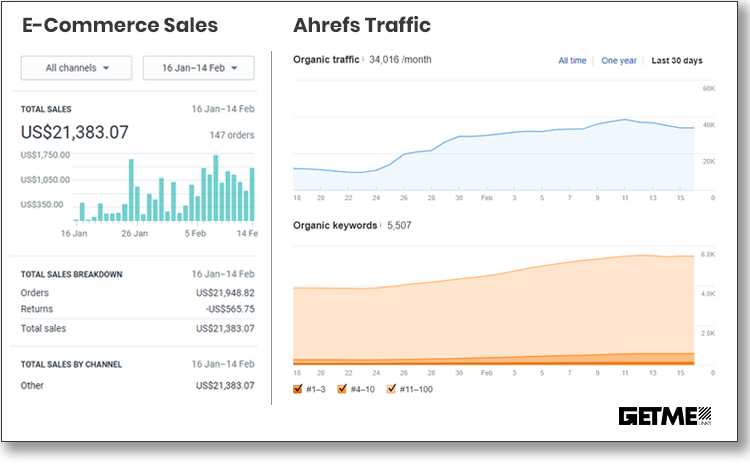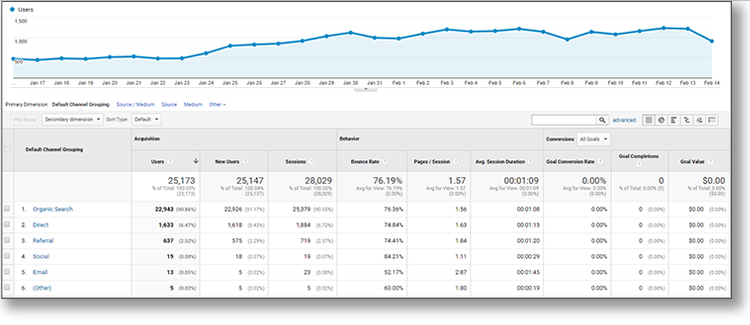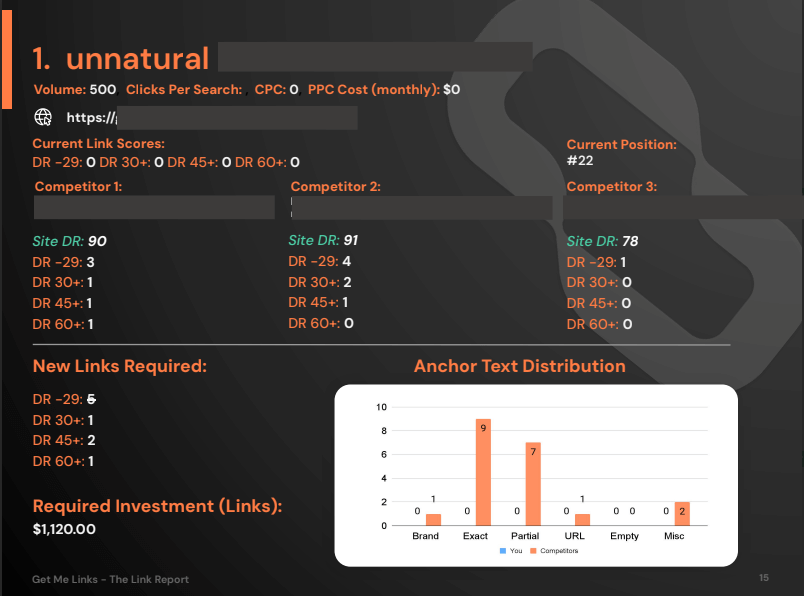0 – 20k+ Per Month Seo Website Case Study (Inc. Screenshots)
250
Links Built
107%
Traffic Increase

$21,383
Revenue Growth
In this post, I’m going to show you how we took a site from 0 – 20K+ in sales per month using organic traffic alone.
Many people know me as the outreach link-building guy, but many peers close to me also know that I successfully run and manage a range of affiliate & e-commerce websites where I put many of the strategies and methods that I discuss on the Get Me Links blog into action.
Here are some promised screenshots:

And, if that wasn’t enough – here’s a mandatory Google Analytics organic traffic screenshot:

As of this month, we’re actually on track for $30k in sales too… Let’s hope we hit it!
In this case study, I’m going to be going over the strategies that we used from inception to create this site and carry out the on-page SEO.
I’ll also talk about exactly what kinds of links we built, along with some information about what links I feel make the biggest differences. I’ll also share some stories that we experienced when building this website towards the end of this case study, so that you can learn from us and not make the same ones.
The reality is, this project didn’t go completely to plan from the start, but SEO is always a journey and your desired outcome might never happen in the time that you expect.
I hope that this case study will give you a more realistic insight as to exactly what you need to keep in mind when you’re trying to make insane amounts of income online using organic search.
ON-PAGE SEO
For anyone who knows me, I take a thorough approach to on-page.
You can read any of the other massively in-depth guides we've published and you'll see that into action.
If I have to condense everything I do in a nutshell, this would be it:
- Cover the entire entity the article targets within the article. If I talk about white-hat links, I cover everything there is to be said about
- Build relevant internal links to other pages to maximize dwell time and internal clicks (SEO could well be summarized to those two things, but that's for another post). See what I did with the link above.
- Keep a tight headings structure from H1 to H4s. Fill those in with semantically rich entities.
- Answer the query QUICKLY and at the top of the article. Then go on with those 4,000 words of nuance AFTER.
- Tight Schema.
That's the 80/20, my On-Page checklist has 58 points so I won't bore you with all of them here (Send me an email if you want a copy, no problemo)
1. Planning Your Pages
I follow a rather tight information architecture on my sites, I'm a firm believe that using hard silos makes everyone's life easier in the long run. Users can find more pages, engines can retrieve information way faster and cheaper, and site managers have a much easier time doing internal links when just following the infrastructure provided on a big a** spreadsheet.
I'll plan out 200+ pieces of content on a session, lay out the silo, and then send it to production. With a clear checklist and AI, it's done very, very fast.
2. Supporting Content
One of the most commonly asked questions I get relates to supporting content. It's 2024 so I'm sure you've all heard of topical authority... and that's basically what I do. I cover all the sub-entities on dedicated pages.
Another very common question is "should these two keywords become two pages or one page covering both?" and I'm the wrong person to ask. The right source is Google. Simply search both keywords.
- Different SERPs? Different pages.
- Same pages ranking for both keywords? Do one page.
3. Content Fine Tuning - Post Publishing
I’ve always been a big fan of fitting in with competition while doing SEO.
On this website, we optimized many of the pages using SurferSEO before many of our jumps so while I can’t say that Surfer was the exact thing that caused some massive results, it’s definitely helped and I will be continuing to use it in my arsenal.
4. Internal Linking
We got some huge boosts by fixing our internal linking.
In terms of anchor text, we kept this very pushy by using a wide range of varied exact match and partial match keywords across all of the pages on the site. All internal links were contextual other than a few menu and footer links.
LINK BUILDING
Okay, now for the part that most of you will be excited about.
Here's the exact process we followed for linking to this site:
1. Using The Link Report to our advantage

We ran a Link Report for our site to map out a comparison to the top 3 competitors and found what was required in terms of DR and topical authority to bridge the gap. That's most important at a page level. We then made some calculations on how many homepage links to build to bring our DR to a similar range to theirs. Here's the breakdown of the links we built:
- 38% of links are Guest Posts
- 44% of links are Link Insertions
- 18% of links are pillow links (mostly socials & citations)
These numbers represent around 350 links, however, we’ve had around 100 natural links come to the website too.
Let’s go over each type of link, where they were used, and why I felt they helped:
2. Guest Posts
Guest posts are my favorite type of links to use at scale for a number of reasons.
I generally like to use these links at the start of projects as they are extremely safe and great for relevance theming, I also like to use them on inner pages on a long-term basis due to the control on relevance that I have with them.
Safety reasons: Guest Posts are safe as I only build links from websites that already have traffic on them.
At Get Me Links, we do a 1000+ Traffic Guarantee on all of our links and I did the exact same filters when I was building links for this website.
Relevance factors: Relevance is very important when you build links to the inner page level but not so much when building links to the homepage. There you can go very broad and it's still safe (for as long as you do branded anchors)
Guest Posts are great for building high levels of relevance as you can have full control over what goes into the article title and you write the content that goes onto that specific page.
Guest Posts on their own are powerful, but they can be leveled up by building Tiered Links to them. All inner page links built had 5+ Tier 2 links pointing to them. We didn't power up the homepage links.
In terms of DR, I just followed the blueprint from the Link Report.
3. Link Insertions
Link Insertions are generally great for homepage theming or for linking to pages that you haven’t got a strong focus on ranking.
I cover more on this in my Link Insertions vs Guest Posts article. On this website, I used them quite strongly on the homepage but made sure that the niche relevance was there on everything.
Link Insertions are unique in that you’re generally getting links on aged posts which can often have referring links too.
The result of this is that you sometimes don’t need to build Tier 2 links at all due to the fact they’ll have external & internal links going to the pages that you are placing on.
I love to mix these up and if I can get my general relevance perfect, I’ll always hit these to the homepage to assist in powering up the website throughout the project.
4. Pillow Links
Separate from these main power areas, I also focused on building a lot of pillow links.
For those of you who don’t know Pillow Links are – Pillow Links are generally not your main links that you build to pass juice and power, they’re built to keep your site looking natural and they allow you to work in more relaxed anchor ratios.
To get a number on how many pillow links to build – I usually take a look at the competition and get ideas that way.
On this site, I built the main social accounts (Facebook, Twitter, Instagram etc…) and I also built around 100 citations.
You can get the exact citations we used here.
5. Link Variety Matters
If you notice my strategy above – I used a wide variety of links going to this website missing up low page authority with high and nofollow with dofollow links for example.
Google understands that any big website that has hundreds of links should naturally have a wide variety of links powering up that website.
I’m considering launching a course shortly that includes a product that correlates data of your competitor's links so that you understand the exact types of links that you should be building, how many you need, and where you should be building them.
It’s essentially going to work like an Off-Page version of Surfer SEO that helps you on the link-building side.
Growth Tips
1. Plan Before You Start
I can’t stress the importance of planning things up front before you start out in your website ranking journey.
Before I started this website, I planned the keywords and got a clear idea of exactly what we could earn from those and I also looked into the competition of each keyword. If you haven’t checked out my competitor backlink analysis guide, then you should definitely read that after this case study! A lot of the info in there was what I used to analyze the competition's links.
I planned everything – I understood the exact pages that we were going to launch, I narrowed in on every possible competitor to steal keywords and we knew up-front estimated costs of what we would need to spend in order to get the results that we were looking for.
Careful planning will reduce risk and give you a realistic view of what you need to do and how you’re going to get there.
I meet too many affiliates or website owners who don’t know their competition and have absolutely no clue as to how many links they need to build to take things to the next level.
2. Be Patient & Don’t Give Up
We started this site halfway through the year and we got some pretty quick results within a few months, getting the site to around $2-3k per month.
Insane results for a site that was a few months old in this particular niche.
This lasted for about a month, and then suddenly the site dropped and we couldn’t figure out why.
At the time, we just kept building links but the rankings just got worse and worse. We got to the point where the site was making zilch and it was barely optimized for anything.
We eventually began to realize that we had changed the web host around the time of the website dropping and there was a crawling issue with our website – Oops!
We revamped the website with new clean content and things began to rise.
I realized from this that generally noticeable rank-ability issues generally come down to one or two main problems – it’s not a mix of a thousand things that hold you back at this level.
It’s important in these situations to diagnose every possibility and be open to testing fixes out.
GROWTH PLANS
As I mentioned earlier in this case study – this site has a potential of much more than we are currently making.
We reckon our top-end potential is around $200k per month from Organic alone, we might never hit this but it’s good to know that we have the potential to scale 10x from where we are right now.
Our growth plans now involve building more direct page authority to specific pages that require more direct page power & we’re working on another website in the same niche which is going to feed in sales to our main brand.
SUMMING THINGS UP
I’m planning on providing more updates on this project shortly as we continue to grow the brand.
We’re now on track for $30k in sales this month, which is absolutely exceptional and I’m ecstatic to continue working on the website and grow it even further.
I hope you got great value out of this, I’d love to hear any feedback or questions in the comments below.
If you ever need help with your link building, you can always reach out to us or you can check out the link below to see our range of link options along with information about each of the products that we offer at Get Me Links.
